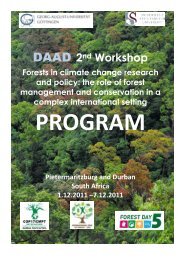Proceedings of the Workshop - Georg-August-Universität Göttingen
Proceedings of the Workshop - Georg-August-Universität Göttingen
Proceedings of the Workshop - Georg-August-Universität Göttingen
Create successful ePaper yourself
Turn your PDF publications into a flip-book with our unique Google optimized e-Paper software.
conditions. A central task <strong>of</strong> silvicultural management is to control <strong>the</strong> competitive<br />
relationships in forests.<br />
This concerns in particular <strong>the</strong> young stands for interspecific competition control<br />
when young trees are to be favored to understory vegetation such as herbs and<br />
grasses.<br />
During <strong>the</strong> longest section in <strong>the</strong> life time <strong>of</strong> a forest manipulation <strong>of</strong> intra-specific<br />
competition, such as by thinning, is done by <strong>the</strong> forest managers to optimize <strong>the</strong><br />
qualitative development <strong>of</strong> stocks.<br />
When, towards <strong>the</strong> end <strong>of</strong> a generally over a one hundred years lasting forest<br />
development, an alternation <strong>of</strong> generations should be initiated and <strong>the</strong> harvestable<br />
forest should be converted into a pr<strong>of</strong>itable consecutive forest stand, silviculture<br />
management develops sustainable concepts <strong>of</strong> natural regeneration <strong>of</strong> forests.How is it<br />
<strong>the</strong>n that silvicultural measures can have a positive effect on <strong>the</strong> global carbon issue?<br />
Locally or regionally already, <strong>the</strong> choice <strong>of</strong> tree species, a major component <strong>of</strong><br />
forest management, <strong>of</strong>fers substantial opportunities through <strong>the</strong> use <strong>of</strong> powerful, i.e.<br />
very productive tree species, to influence carbon sequestration <strong>of</strong> forests.<br />
But it needs to be kept in mind that highly productive species will meet <strong>the</strong> claim<br />
<strong>of</strong> a high carbon sequestration if <strong>the</strong>y are adapted to each location.<br />
This adjustment relates to both <strong>the</strong> climatic conditions as well as soil science.<br />
Figure 1: Scheme <strong>of</strong> <strong>the</strong> natural carbon cycle<br />
Let's first have a look at <strong>the</strong> climate problem we try to influence by silvicultural<br />
means. The so-called greenhouse effect is caused by greenhouse gases, carbon<br />
dioxide, which is one <strong>of</strong> <strong>the</strong>m, remains by far <strong>the</strong> highest share <strong>of</strong> <strong>the</strong> global warming<br />
however. Therefore it is important to consider <strong>the</strong> global carbon cycle (Fig. 1). There<br />
‐ 12 -










